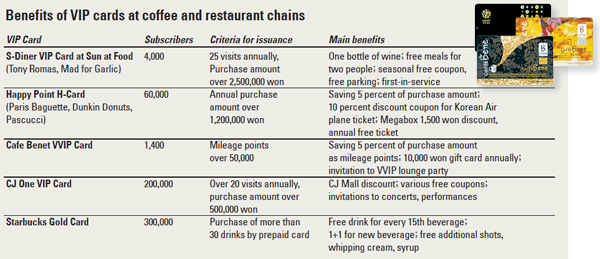Food-service industry lures in customers with VIP cards

Points cards have never been so classy. As the use of so-called VIP cards rises in the food-service industry, companies are finding new ways to lure in their customers and make them feel like an important part of the franchise.
With a variety of benefits and rating systems related to purchase amounts and the number of visits, VIP cards are evolving from their current single memberships.
Coffee and restaurant chains are differentiating themselves by offering various VIP cards used to earn and save points. The marketing strategy aims to make customers feel that “the more they purchase, the more they will be treated as a VIP.”
SPC Group, which operates Paris Baguette, Dunkin Donuts and Pascucci, newly introduced a four-stage grading system with its “Happy Point” card last month. Sun at Food, owner of Tony Romas, Mad for Garlic and Morac, divided its S-Diner card into three stages earlier this year.
Starbucks and Cafe Bennet are also issuing VIP membership cards.
Sun at Food offers VIP customers a free valet parking service, first-in advantage without a reservation and an invitation to a VIP party, while SPC gives out a 10 percent discount on airline tickets from Korean Air.
Food-service businesses are enjoying the effects of attracting more customers with the new marketing strategy. SPC cited an increase in 30,000 card members. The number of annual subscribers for the S-Diner card has also doubled from 20,000 to 40,000.
The new subscribers, who are not yet VIP members, flock to shops to spend more and accumulate track records.
The cards are designed differently as well. Starbucks engraves the name of the customer as well as a customized phrase on their shiny Gold Card.
Other points cards also started inscribing letters in gold and silver on their black exteriors, distinguishing VIPs from general members. It’s an easy way to look fancy while dishing out less money.
The food-service industry was unanimous in its condemnation of expensive VIP systems at department stores and credit card companies.
“We target those who wish to be treated as a VIP but feel too much burden with the expensive requirements,” said an employee at CJ One.
Yoo Jae-gon, a 27-year-old company worker, said he went to Starbucks to buy coffee for two straight months only to obtain the Gold Card.
“I wanted to own a special card that other people generally don’t have. I am satisfied that I now possess a VIP card without spending a lot of money,” he said.
There are people who have five to six VIP cards from restaurants. Yoon Ji-hyun, a 25-year-old college student, is a VIP at five different restaurants.
“The more food-service premium cards, the better,” she said.
According to Starbucks, more than 300,000 of its Gold Card members stopped by the coffee franchise once every two days on average. Thanks to the regular visits, sales of Starbucks in the first quarter of the year jumped by 15 percent on-year, Starbucks said.
Members of Cafe Bennet’s VIP card were said to spend more than 300,000 won every month on average.
By Cho Hye-kyung [kjy@joongang.co.kr]










with the Korea JoongAng Daily
To write comments, please log in to one of the accounts.
Standards Board Policy (0/250자)